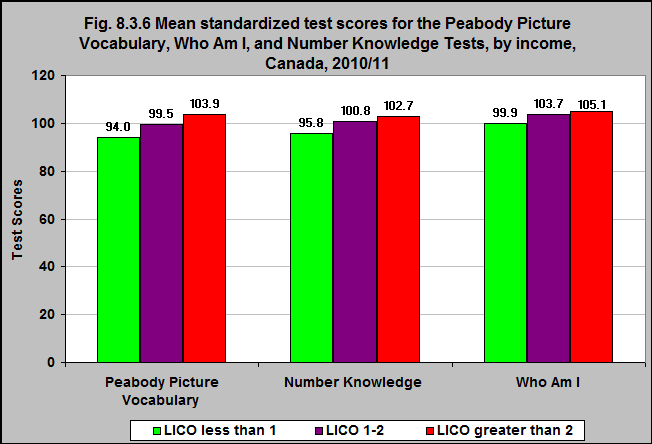Mean standardized test scores for the Peabody Picture Vocabulary, Who Am I, and Number Knowledge Tests, by income, Canada, 2010/11

Notes:
*There are a number of measures of school readiness/academic ability among 4- and 5-year-olds.
The Peabody Picture Vocabulary Test assesses a child’s verbal ability and scholastic aptitude by having them look at pictures and identify the picture that matches a word spoken by an interviewer.
The Who Am I? test involves copying and writing tasks. The copying tasks in the assessment are designed to assess the child’s ability to conceptualize and reconstruct a geometrical shape. The writing tasks assess the ability of the child to understand and use symbolic representations such as numbers, letters and words. The child’s ability to complete the tasks depends on many factors including maturity, culture, experiences, and language skills.
The Number Knowledge test assesses a child’s ability to understand and use numbers.
Source: CICH graphic using data adapted from the Survey of Young Canadians 2010/2011, Statistics Canada, custom run.
The mean scores for the Peabody Picture Vocabulary, Number Knowledge and Who Am I school readiness tests were higher among children living in higher income communities than in lower (using the LICO**).
**The low income cut-offs (LICOs) are income thresholds below which a family will likely devote a larger share of its income on the necessities of food, shelter and clothing than the average family. The approach is essentially to estimate an income threshold at which families are expected to spend 20 percentage points more than the average family on food, shelter and clothing. For 2011, the 1992 based after-tax LICO for a family of four living in an community with a population between 30,000 and 99,999 is $30,487, expressed in current dollars. Accessed February 24, 2017 at http://www.statcan.gc.ca/pub/75f0002m/2012002/lico-sfr-eng.htm
